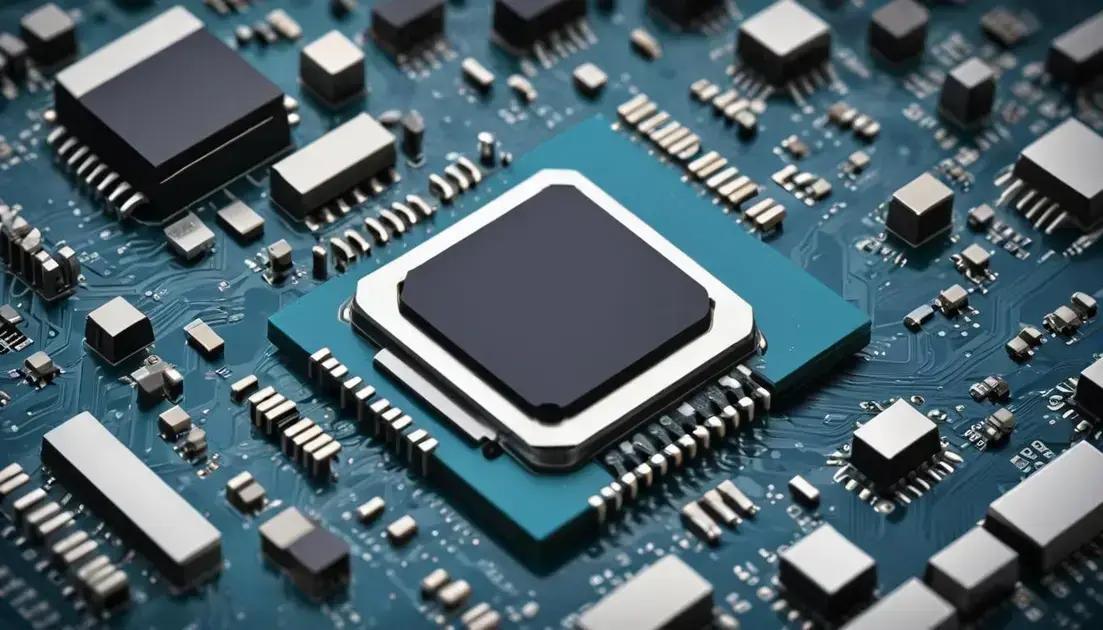
Integrated Circuit: Brain of Devices
Integrated circuits are essential in modern electronics, comprising numerous transistors that amplify and switch electrical signals. The future of semiconductors is promising, with advances such as new materials like graphene and the impact of AI on chip design. These developments will lead to faster, more efficient devices, enhancing everyday technology and fostering innovation in various fields.
Have you ever wondered how Integrated Circuits became the backbone of modern electronics? With thousands of transistors packed into tiny chips, they define our technological world today.
Understanding Integrated Circuits
Understanding Integrated Circuits is simpler than it sounds! These tiny components are essential in all kinds of electronic devices. From your smartphone to gaming consoles, they play a huge role.
At their core, integrated circuits contain many transistors. Transistors act like tiny switches that control the flow of electricity. This helps devices process information quickly and efficiently.
Why are integrated circuits important? Well, they allow for smaller and more powerful devices. Imagine having a computer that fits in your pocket! That’s possible because of these amazing chips.
Integrated circuits come in different types. Some are analog, while others are digital. Analog circuits deal with continuous signals, while digital ones work with binary data, like 0s and 1s.
How They’re Made
The creation of integrated circuits involves complex processes. Engineers design them using computer-aided tools. They then fabricate chips using materials like silicon, which is critical for making them function.
After production, testing is key. Manufacturers check for errors to ensure that each chip performs well. If they find issues, they’ll fix them before the chips reach consumers.
Overall, understanding integrated circuits helps us appreciate technology more. We often take these tiny wonders for granted, but they are the driving force behind modern electronics.
Role of Transistors in ICs
Role of Transistors in ICs is crucial for understanding how integrated circuits work. Transistors are tiny switches that help control electrical signals. They can amplify signals or turn them on and off.
In integrated circuits, thousands or even millions of transistors are packed into a small space. This allows devices to perform complex tasks quickly. For example, your phone can run apps and connect to the internet thanks to these little components.
Each transistor has three parts: the emitter, base, and collector. When you send a signal to the base, it allows electricity to flow from the emitter to the collector. This is how they switch on and off.
Transistors also help in amplifying signals. This means they can take a weak electrical signal and strengthen it. This process is vital for making sure you get clear sound and images on your devices.
Types of Transistors
There are different types of transistors used in integrated circuits. The most common ones are Bipolar Junction Transistors (BJTs) and Field-Effect Transistors (FETs). Each type has its own unique function and benefits.
BJTs are often used for amplification, while FETs are great for switching. Knowing which transistor to use can improve overall performance in circuits.
In summary, transistors are the heart of integrated circuits. They enable your devices to work efficiently and perform various functions. Without them, modern electronics wouldn’t be what they are today.
Future of Semiconductors
The Future of Semiconductors looks bright and full of possibilities. Semiconductors are essential for modern technology. They are in everything from phones to electric cars.
As technology evolves, so do semiconductors. Innovations in this area improve speed and efficiency. For example, new materials like graphene are being tested. Graphene is super strong and conducts electricity well.
Another exciting trend is the growth of quantum computing. This technology could change how we process data. Semiconductors will play a key role in making quantum computers work effectively.
We’re also seeing a push for energy-efficient semiconductors. These chips help reduce power consumption in devices. This is great for the environment and can save users money.
The Role of AI
Artificial Intelligence (AI) will greatly influence semiconductor design. AI helps engineers create better chips faster. It can analyze large amounts of data to find optimal designs.
As AI technology advances, it will drive semiconductor innovation even more. Expect to see new applications and devices powered by these advancements.
Collaboration among companies is key. Tech firms are teaming up to share knowledge and resources. This will speed up semiconductor development and open doors to new possibilities.
In conclusion, the future of semiconductors is full of potential. As we embrace new materials and technologies, our devices will continue to improve and become more powerful.
Conclusion
In conclusion, understanding the role of transistors and the future of semiconductors is vital in our tech-driven world. Transistors are the building blocks of integrated circuits. They allow our devices to function effectively and efficiently.
As we look toward the future, innovations in semiconductor technology promise exciting developments. From new materials like graphene to AI-driven designs, the possibilities are endless. These advancements will continue to improve the performance of electronic devices.
By keeping up with these trends, we can appreciate the technology that powers our everyday lives. Embracing these changes will lead us to a smarter and more connected future, where technology enhances our experiences like never before.


